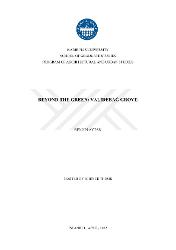| dc.contributor.advisor | Erdem, Arzu | |
| dc.contributor.author | Aytan, Rengin | |
| dc.date.accessioned | 2023-10-17T20:46:22Z | |
| dc.date.available | 2023-10-17T20:46:22Z | |
| dc.date.issued | 2023 | |
| dc.identifier.uri | https://tez.yok.gov.tr/UlusalTezMerkezi/TezGoster?key=j_Fjwp4JS4mk97Puqti8rg-0sPC-FvxwaZQLI5PIS-UkejClIg3cuvemBF2xVKFx | |
| dc.identifier.uri | https://hdl.handle.net/20.500.12469/4525 | |
| dc.description.abstract | Validebağ Korusu, İstanbul metropolünün ortasında tasarlanmamış en büyük doğal yeşil alanlardan biri olma özelliğini taşıyor. Bununla birlikte tarihsel sürecinde, farklı otoriteler tarafından yeniden üretilerek kontrol edilebilir bir alana dönüştürülmeye çalışılmıştır. Bu girişimlere karşı, Validebağ Gönüllüleri'nin yirmi yılı aşkın bir süredir verdikleri mücadele ile koru, kent içinde önemli bir toplumsal mekan haline gelmiştir. Bu çalışma, Validebağ Korusu'nun mekansal ve toplumsal üretim süreçlerini Lefebvre'nin (1991b) "mekanın üretimi" kuramı çerçevesinde analiz ederek kentte bir toplumsal mekan olarak koru mekanının yeşil alan olmanın ötesinde çoğullaşan mekansal karşılıklarını ortaya koymayı amaçlar. Osmanlı döneminde saray mülkiyetinde olan, Cumhuriyet sonrası ise politik ve ekonomik olarak değeri farklılaşan korunun içinde ve çevresindeki yapılaşmalar artmıştır. İçine eğitim ve sağlık yapıları yapılırken, çevresine kapsamlı konut projeleri yapılmıştır. Ancak 1990'lı yıllarda kentliler, korunun doğal ve toplumsal değerlerini savunarak, yapılaşmalara istinaden iktidara karşı bir direniş başlatmıştır. 2001 yılında kurulan Validebağ Gönüllüleri aracılığıyla devam eden koru direnişi bir kentsel hareket olarak sürmekte ve korunun toplumsal üretimine dahil olmaktadır. Toplumsal üretim süreçlerinde korunun mekansal, söylemsel ve toplumsal temsilleri zaman içinde belirli kırılma noktalarında farklılaşarak çoğalmıştır. Bu bağlamda Lefebvre (1991b), mekanın toplumsal üretim sürecini algılanan, tasarlanan ve yaşanan boyutları içinde kavramsallaştırır. Peki tarihsel sürecinde, iktidar stratejilerinde, protestolarda ve gündelik yaşamda Validebağ Korusu nasıl üretilmektedir? Bu çalışma, Validebağ Korusu'nun toplumsal üretim süreçlerini tarihselliği içinde araştırmakta, korunun temsili ve mekânsal pratikleri arasındaki ilişkileri vurgulamaktadır. Korunun kentliler tarafından algılanan, belediye tarafından tasarlanan ve gönüllüler tarafından yaşanan sembolik mekansal ölçütleri arasında karşılıklı bağlantılar ve çatışmalar vardır. | en_US |
| dc.description.abstract | Validebağ Grove is the largest green area without a designed landscape in the middle of the Istanbul metropolis. However, different authorities have tried to transform the grove into a controllable space by dominating the landscape. Against these intentions, Validebağ Volunteers have been defending the grove for over twenty years. Consequently, Validebağ Grove became a significant social space in the city. This study analyzes Validebağ Grove's spatial and social production processes within Lefebvre's (1991b) theory. To that extent, it aims to reveal the pluralized spatial qualities beyond being a green area. In the Ottoman period, Validebağ Grove was the Sultan's property and opened to the public after the Republic period. Also, since the 1980s, it has become valuable area for municipalities and capitalist actors. While public buildings were built inside the grove, extensive housing projects were built around it. However, in the 1990s, citizens started a resistance against the municipalities regarding the construction, defending its natural and social values. Since 2001, "Validebağ Volunteers" was established, and through that association, the citizens systematized their urban struggle against the municipality. With this struggle, Validebağ Grove has become a space -and object- of urban resistance. In this sense, its social representations multiplied in protest banners, news headlines, and promises of power. In this context, Lefebvre (1991b) conceptualizes the social production process within perceived, conceived, and lived dimensions. In these dimensions, different dimensions of space are produced simultaneously. So, how is the meaning of Validebağ Grove producing in strategies, protests, and everyday life? To answer this question, it is possible to use Lefebvre's (1991b) spatial moments as a theoretical tool. This study explores Validebağ Grove's social production processes and highlights relations between the grove's representational and spatial practices. There are interconnections and conflicts between the spaces perceived by citizens, conceived by the municipality, and lived by the Volunteers. | en_US |
| dc.language.iso | eng | en_US |
| dc.publisher | Kadir Has Üniversitesi | en_US |
| dc.rights | info:eu-repo/semantics/openAccess | en_US |
| dc.subject | Mimarlık | en_US |
| dc.subject | Architecture ; Peyzaj Mimarlığı | en_US |
| dc.title | Beyond the green: Validebağ grove | en_US |
| dc.title.alternative | Yeşilin ötesinde: Validebağ korusu | en_US |
| dc.type | masterThesis | en_US |
| dc.identifier.startpage | 1 | en_US |
| dc.identifier.endpage | 133 | en_US |
| dc.department | Enstitüler, Lisansüstü Eğitim Enstitüsü, Mimarlık Ana Bilim Dalı | en_US |
| dc.institutionauthor | Aytan, Rengin | |
| dc.relation.publicationcategory | Tez | en_US |
| dc.identifier.yoktezid | 807439 | en_US |
| dc.khas | 20231017-Tez | rn_US |
















